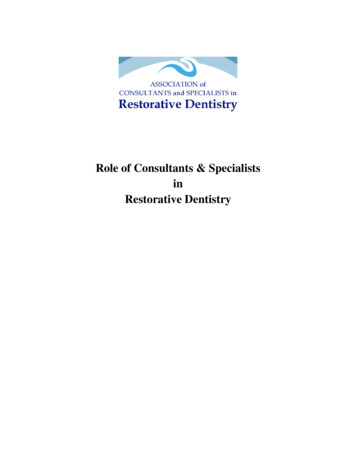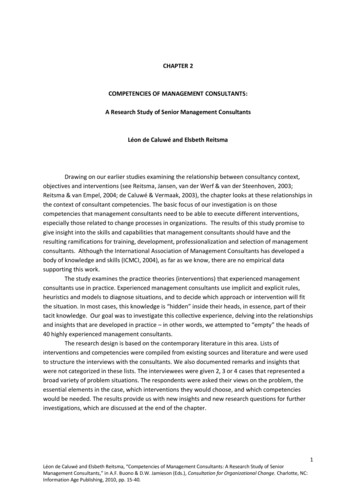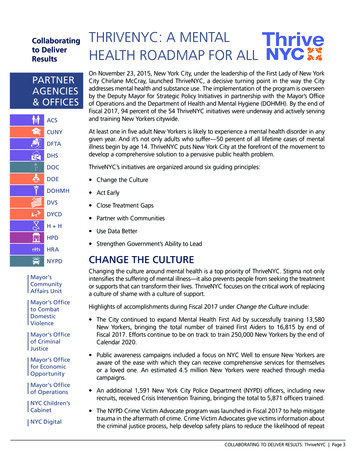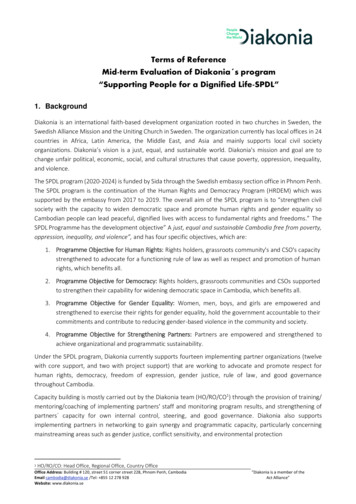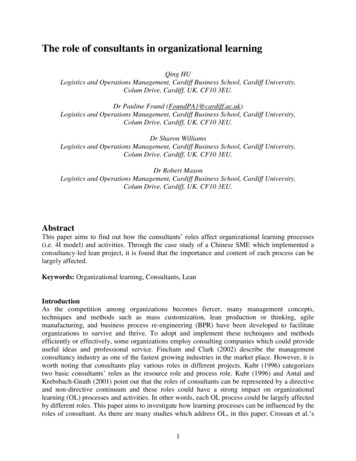
Transcription
The role of consultants in organizational learningQing HULogistics and Operations Management, Cardiff Business School, Cardiff University,Colum Drive, Cardiff, UK. CF10 3EU.Dr Pauline Found (FoundPA1@cardiff.ac.uk)Logistics and Operations Management, Cardiff Business School, Cardiff University,Colum Drive, Cardiff, UK. CF10 3EU.Dr Sharon WilliamsLogistics and Operations Management, Cardiff Business School, Cardiff University,Colum Drive, Cardiff, UK. CF10 3EU.Dr Robert MasonLogistics and Operations Management, Cardiff Business School, Cardiff University,Colum Drive, Cardiff, UK. CF10 3EU.AbstractThis paper aims to find out how the consultants’ roles affect organizational learning processes(i.e. 4I model) and activities. Through the case study of a Chinese SME which implemented aconsultancy-led lean project, it is found that the importance and content of each process can belargely affected.Keywords: Organizational learning, Consultants, LeanIntroductionAs the competition among organizations becomes fiercer, many management concepts,techniques and methods such as mass customization, lean production or thinking, agilemanufacturing, and business process re-engineering (BPR) have been developed to facilitateorganizations to survive and thrive. To adopt and implement these techniques and methodsefficiently or effectively, some organizations employ consulting companies which could provideuseful ideas and professional service. Fincham and Clark (2002) describe the managementconsultancy industry as one of the fastest growing industries in the market place. However, it isworth noting that consultants play various roles in different projects. Kubr (1996) categorizestwo basic consultants’ roles as the resource role and process role. Kubr (1996) and Antal andKrebsbach-Gnath (2001) point out that the roles of consultants can be represented by a directiveand non-directive continuum and these roles could have a strong impact on organizationallearning (OL) processes and activities. In other words, each OL process could be largely affectedby different roles. This paper aims to investigate how learning processes can be influenced by theroles of consultant. As there are many studies which address OL, in this paper, Crossan et al.’s1
(1999) 4I model (i.e. intuiting, interpreting, integrating and institutionalizing) which illustratesthe dynamic of organizational learning is employed.Literature reviewOrganizational learningThe definition of OLNumerous studies can be found in the area of OL but there is no standard definition orinterpretation of OL. Some researchers (e.g. Cangelosi and Dill (1965), March and Olsen (1976))emphasize that OL means the adaption to internal or external environment changes. While Fioland Lyles (1985) argue that although contextual factors such as culture, strategy, organizationalstructure and environment can affect learning activities, adaption should not be confused withlearning. They point out that adaption means adjustments or modifications based on theenvironment changes but learning stands for knowledge and insight development and thelinkages between effective past actions and future actions (Fiol and Lyles 1985). It implies thatadaption is more passive rather than proactive and it may not contribute to knowledge or insightdevelopment.Fiol and Lyles’ interpretation of learning is confirmed and developed by other researchers.For example, Miller (1996) describes OL as activities to acquire new knowledge which could beimplemented in decision making processes or affecting other organizations. Sadler-Smith et al.(2001) and Lopez et al. (2005) agree that OL refers to the acquisition and development ofknowledge and skills to achieving better organizational effectiveness or performance. However,from Crossan et al’s perspective, OL is more than knowledge creation, acquisition ordevelopment. They point out that OL is “a principle means of achieving strategic renewal of anenterprise” (Crossan et al. 1999: 522). In other words, OL could occur at all the levels of theorganization such as individual, group and organizational levels and the tension between learningnew knowledge and taking advantage of the learned one is the central issue of OL (Crossan et al.1999).OL sourcesOrganizations can learn from both internal and external sources. Experience of the organizationsuch as routines which has been adopted by individuals or groups or the organization (Levitt andMarch 1988), organizational self-appraisal which examines and solves errors or problems orreflection of failure within the organization (Argyris 1976, Daudelin 1996, Huber 1991,Shrivastava and Schneider 1984), can be viewed as the foundations of OL sources. Thoseroutines or activities which could achieve positive results are more likely to be accepted andadopted by other employees in the organization (Cyert and March 1963, Levitt and March 1988).However, Argyris (1976, 1977) claims that OL is associated with error detection and correctionand similarly Daudelin (1996) and Popper and Lipshitz (2000) argue that failure can also be apotential source of OL. In addition to the internal sources, indirect experience from otherorganizations or professionals such as customers, suppliers, management consultants,governmental advisers or other successful organizations can also facilitate OL. For example,Fletcher and Harris (2012) who have investigated ten cases of Scottish organizations whichattempted to achieve internationalization found that consultants could provideinternationalization knowledge to these organizations. Similarly, external sources such as2
consultants and professionals enable organizations to learn new knowledge based on theirexpertise and skills through training and implementing specific projects (Easterby-Smith andAraujo 1999).OL processesBy reviewing OL literature, a number of frameworks or models which describe and analyze OLprocesses or stages can be found. Among these models or frameworks, some researchers preferto view OL processes as several highly structured and distinct constructs. For example, Huber’s(1991) study identifies four typical constructs of OL (i.e. knowledge acquisition, informationdistribution, information interpretation and organizational memory). Similarly, Nevis et al.(1995) affirm that there are three important stages of OL including knowledge acquisition,knowledge sharing and utilization. However, it is argued by many researchers that OL processesare interacted with each other. In other words, one process or level can affect other processes orlevels of OL. For example, Buckler (1996) points out that learning processes cover threeelements (i.e. focus, environment and technique) and these three elements can overlap and beinterdependent with each other. Lam (2001) develops a three-dimensional model of OL whichillustrates how these dimensions are interconnected with each other. Williams’ (2001) belieffocused process model of OL which conceptualizes and presents the social interactions betweenOL processes is also a typical example. Although the above examples recognize the interactionsbetween processes, they lack a clear analysis of different levels of OL.In this study, we employ Crossan et al’s (1999) 4I model of OL which is widelyaccepted and applied by a large number of researchers (e.g. Holmqvist 2004, Schilling and Kluge2009, Vera and Crossan 2004). It considers both different levels of OL, interaction between theselevels and reveals the dynamic of OL processes. In Crossan et al.’s (1999) model, there are fourmain OL processes (i.e. intuiting, interpreting, integrating and institutionalizing) that relate tothree levels of learning (individual, group and organization). Crossan et al. (1999) reject theperspective that OL is purely analytical and a conscious process by positing that learning couldoccur subconsciously. They argue that intuiting which means recognizing patternssubconsciously at the individual level is crucial to OL processes (Crossan et al. 1999). Theirperspective of intuiting is later supported and confirmed by other researchers (see Akinci andSadler-Smith 2012, Sinclair and Ashkanasy 2005). For example, Sinclair and Ashkanasy (2005)define intuition as “a non-sequential information-processing mode which comprises bothcognitive and affective elements and results in direct knowing without any conscious reasoning”(Sinclair and Ashkanasy 2005:353) and their model of decision-making clearly differentiatesintuitive decision-making from analytical decision-making (Sinclair and Ashkanasy 2005). Inaddition to intuiting, the second process-interpreting-enables individuals to consciously explaintheir insights or ideas through various languages and develop their cognitive maps (Crossan et al.1999).It is agreed by researchers that language is central to interpreting (Walsh 1988, Weick,1979). As individuals may explain the same phenomenon differently, the issue of equivocalitycould occur. However, according to Crossan et al. (1999), this issue can be solved by groupinterpretive process. Compared to interpreting, the process of integrating emphasizes thedevelopment of collective action based on shared understanding across group members and thedeeper shared understanding can be achieved through dialogue among group members (Crossanet al. 1999). The process which distinguishes learning at organization level from learning atindividual or group level is institutionalizing. By proposing the assumption that OL does not3
simply equal the sum of individual or group learning, Crossan et al. (1999) indicate that somelearning results can be integrated and embedded in organizational strategy, structures, systems,practices and investments. They also suggest that it is not necessary for learning to go throughevery process and sometimes, some processes can be skipped. Although Crossan et al.’s (1999)study shows a rich and in-depth understanding of OL processes, some researchers argue that asOL includes various sources, it is also meaningful to extend the understanding of the 4I modelfrom intra- to inter-organizational level (Crossan et al. 2011, Jones and Macpherson 2006). Inother words, researchers should clarify how these 4I learning processes within the organizationcan be changed or affected by the inter-organizational level which in this paper we usemanagement consultancy as a proxy.Management consultancyThe definition of management consultancyTrying to find out one unified definition of management consultancy can be problematic as it isdefined differently by researchers. According to Sturdy’s (2011) study which reviews andexamines the literature of management consultancy, there are two dominated types of definitions.One type highlights activities that could assist or facilitate organizational change or improvement(Block 2000). It implies that in addition to the experts or professionals outside the organization,any employee within the organization that provides help to others or the organization can beconsidered as the consultant. Compared to this broad and inclusive definition, the other typegives a narrower definition. It proposes that management consultancy is a special andprofessional service provided by specially trained and qualified persons (Greiner and Metzger1983). Based on these two distinct definitions, Kubr (2002) suggests a clearer and morefundamental definition of management consultancy which is employed in our study. From hisperspective, management consultancy or consulting is defined as “an independent professionaladvisory service assisting managers and organizations to achieve organizational purposes andobjectives by solving management and business problems, identifying and seizing newopportunities, enhancing learning and implementing changes” (Kubr 2002:10).The roles of consultantsResearchers have established different typologies of roles of consultants from variousperspective and dimensions (e.g. Kitay and Wright 2003, Nees and Greiner 1985, Turner 1982).Among these studies, there are two well-known typologies. One is resource (or content) role vs.process role and the other is directive and non-directive continuum. In the resource role theconsultants are expected to provide a specific service to the client based on their expertise. Inthe content role consultants need to facilitate and enable the client to understand their ownorganization and its processes (Kubr 2002, Massey and Walker 1999). Kubr (2002) suggests thatthese two types are the basic roles of a management consultancy and given the complexity of itsactual activities, he then proposes a more comprehensive typology of consultants’ roles whichcan be presented in a directive and non-directive continuum (see Kubr 2002: 74). In this study,we mainly employ the continuum to specify consultants’ roles.Research methodsIn this study, a single and in-depth case study is adopted for three reasons. First, according toHandfield and Melnyk (1998), a case study are employed for the following research purposes: 1)4
exploration (i.e. to understand the uncovered domains of previous theories); 2) theory building(i.e. to identify key variables, their relationships and the reasons for these relationships); 3)theory testing (i.e. to test the previous theories); 4) theory extension (i.e. to better structure thetheory based on the observed results). In this study, as the main purpose is to identify the casualeffect relationship between the roles of consultants and OL processes, case study can be viewedas the most suitable research method. Second, as suggested by Yin (2009), case study is mostsuitable for answering “how” and “why” questions which could contribute to both theory testingand building. In this study, as the research question is a “how” question, it is reasonable tochoose a case study approach. Third, in terms of the choice of cases, Voss et al. (2002) point outthat single and in-depth case study is commonly used in longitudinal research. In this study, oneof the authors had a unique opportunity to get access to a Chinese SME (Small and MediumEnterprise) in the foundry industry which was implementing a lean project with the support froma consulting company from Feb 2012 to Jan 2013. During this period, the author visited thiscompany twice: the first visit was at the early-to-mid stage of the project from Feb 2012 to May2012 and the second visit was at the mid-to-end stage from Nov 2012 to Jan 2013.To aid the rigorous collection of data some instruments for case study were employed.Yin (2009) suggests that the interview can be viewed as a vital source for case study. In thisstudy, one of the most important instruments is the semi-structured interview. Gubrium andHolstein (2001) indicate that compared to structured and unstructured interview, semi-structuredinterview possesses unique strengths. On the one hand, some closed questions can enable theresearcher to compare and contrast answers from interviewees and on the other hand, some openended questions can be asked to gather rich information. To understand the learning processeswhich occur at different levels and the roles of consultants, managers, consultants, supervisorsand operators were interviewed. For managers, they were interviewed with the focus on theirpast experience of lean, their attitudes and understanding towards lean and reasons to employconsultants and their expectations of consultants. For consultants who were directly responsiblefor the project, they were interviewed in terms of their interpretation of their roles, theirunderstanding of lean, learning and training issues or difficulties in the project. For supervisorsand operators who attended different workshops, they were interviewed in relation to f theirattitudes and interpretations of lean, courses delivered by consultants and learning andcommunication issues. All the interview transcripts were transcribed and then sent tointerviewees to confirm these were a accurate recording of the interview.In addition to the semi-structured interviews, direct observation and documentation werealso employed to enrich the case study. For direct observation, the author was given access to theshop-floor, training courses and meetings to observe how managers, supervisors and operatorsworked and communicated with each other and how training courses were delivered byconsultants or managers. The documentation included materials from, the training courses, theimprovement project plan, the implementation handbook, reports from consultants and newdocuments of rules and performance assessment. To analyze different sources of data in a logicalway, a group of codes such as consultants’ roles, 4I processes, categories of lean definitions weregenerated and developed from literature prior to collating any data. New codes were alsodeveloped and added during data analysis.FindingsThe roles of consultants5
Through the content analysis of the interview transcripts and data from observation anddocumentation, four types of roles are identified.The first one is trainer. It is found that both managers and consultants mentioned this rolefrequently during the interviews. From the managers’ perspective, consultants can be labeled astheir “teacher” who possessed “various types of knowledge and experience” in this area andeducated them to understand and implement lean. From the consultants’ perspective, they wereresponsible for training the managers and employees in terms of the meaning of lean, theapproaches and requirements of lean.The second role identified is the advocate. It is found that one of the most importantreasons for managers to choose lean implementation is as a result of the recommendation fromthe consultants. During the first meeting, the consultants explained the benefits of implementinglean, such as cost reduction, quality improvement and employee quality enhancement andsuccessful cases of lean implementation after the managers described their difficulties andproblems the organization was experiencing. In this case, the consultants persuaded their client(the case company) to select and adopt a particular solution (i.e. lean) and the introduction ofbenefits and successful cases convinced the managers that lean is a suitable and valuable solution.Additionally, the consultants also designed and proposed the detailed plan and guidelines forlean implementation. It is worth noting that the role of the advocate should not be confused withthe collaborator in problem-solving or identifier of alternatives. The advocate tries to promotespecific ideas or solutions and persuade managers to accept and adopt these ideas or solutionsrather than providing alternative solutions. In the case of this project, the consultants offered onedetailed plan for the whole project which they believed could be the most suitable andcomprehensive approach (including organizational, operational and technical levels of changes)rather than several alternative plans. Additionally, when applying lean tools such as 6S andvisual management, the consultants directly provided 6S implementation and assessment methodwhich formulated what, why, where and how to change the status quo by using 6S.The third role is the fact-finder. The consultants investigated the status quo (e.g.organizational structure, culture, employee quality, shop floor management) of the case companythrough interviewing managers and employees and observing their management, productionprocesses and shop floor during the preparation stage to identify the problems, potentialimprovement areas and the main focuses of the project.The final role identified is the one of technical expert. When interviewing managers, itwas found that they described themselves as having a “lack of sufficient knowledge of lean” andtherefore the most important reason to employ consultants is for their experience and knowledgeto cope with problems. In other words, the consultants could provide a professional service. Forthe consultants, it was evident that they had developed their lean based knowledge from bothdirect and indirect experience. For indirect experience, they invited professors in academia andexperts in the consulting industry (who had successfully completed lean implementation projects)to deliver lean based training courses to enable them to better understand the concepts andpractices. Additionally, the consulting company purchased some databases which cover a widerange of trade magazines and academic journals to enable the consultants to learn from variouscases.For direct experience, the consultants were required to submit monthly reports to reflectthe tasks completed, the results that were achieved, the problems or difficulties they identifiedand the plan or solutions for the next step. By the end of project, the consultants were requiredto submit a full project report which reflected their tasks and achievements. By writing the6
reports, the consultants were able to record, review and reflect their experience in a regular andstructured way and therefore, learn from this reflection. In summary, although the consultantsacted as fact finder, which is closer to non-directive side at the beginning of project, it is evidentthat the roles in this project are more directive and resource based.Consultants’ roles and OL processesIn terms of how the consultants’ roles affect OL processes, it is found that the importance andfocuses or content of each process can be changed.Consultants’ roles and IntuitingThe importance of intuiting is largely reduced. As documented in Section 2.1.3, intuiting is animportant process for OL. The results of this case study suggest that intuiting is weakened fortwo main reasons. One reason is that the process of intuiting at an individual level is largelyreplaced by the roles of consultants. For example, as the consultants acted as the fact finder, theywere mainly responsible for identifying problems and potential solutions by using different datacollection methods (i.e. interviewing employees and managers, getting access to companydocuments, sending mini-questionnaires and observing shop floor) and analytical tools (i.e.statistical analysis such as descriptive statistics of mini-questionnaire, content analysis ofcompany documents or reports and interviews). Through this analytical work, a report of the‘status quo’ can be generated. This report can also be viewed as the source for their planningprocess and evidence for persuading managers to accept their plan. In other words, instead of theemployees or managers, consultants recognized patterns or problems by using professional datacollection methods and analytical tools. It may be argued that the consultants could recognizepatterns subconsciously or directly identify patterns based on their expertise and experience.However, when interviewing the consultants, it was found that they rarely use intuition. Theconsultants explained that they needed to show the evidence for their proposed plan or guidelinethrough scientific methods. It implies that when playing a directive role particularly as anadvocate, consultants needed to list and analyze reasons and benefits to persuade managers andtherefore, it is automatically a counterintuitive process. The other reason is that lean itself iscounterintuitive. Emiliani (1998) points out that managers’ intuitive or natural way of thinking isbatch and queue production mode rather than lean. Hence, wastes identified by lean thinkerscannot be recognized by managers unless they are educated to learn lean tools or lean concepts(Emiliani 1998). In the case of this study, most managers and employees have not been trained ortaught lean based knowledge. Therefore, it is less likely for them to intuitively recognize wasteor process improvement opportunities.Consultants’ roles and Interpreting and IntegratingThe importance of interpreting and integrating is enhanced and these two processes which couldoccur at both individual and group levels can be viewed as the core processes for both themanagers and employees to understand lean. As training courses delivered by the consultantswere the main pathway for managers and employees’ learning, how to interpret lean in anunderstandable and acceptable way can be a difficult challenge for consultants. By observingtheir training courses, it was found that these were mainly delivered through lectures (theconsultants acted as trainer or teacher while the managers or supervisors or operators acted asstudents). However, when interviewing some of the “students” after the first training course,which mainly focused on organizational structure and job responsibility, negative feedback was7
received. Some “students” complained that they could not memorize what the consultants hadsaid as they were not familiar with conceptual words or phrases such as flattening and hierarchy.Several “students” highlighted that the examples or cases employed by consultants did not linkclosely with their daily jobs and thereby, they did not know what or how to change. It impliesthat the consultants failed to develop common language to interpret the training materials.Additionally, as “students” could not memorize or understand the training course, it was difficultfor them to change their existing mindset, or develop shared understanding or engage in theproject. Hence, finding a common language or at least an acceptable language to interpret thetraining courses became a core issue. To deal with this issue, the managers and consultantsdecided to change the training method. As managers knew their company and employees betterthan the consultants, and also as the consultants worked closely with the managers during theproject, the consultants attempted to train the managers first. Managers were then expected todeliver the training courses with the common language to supervisors or operators. In this case,the consultants acted as “head trainers or coaches” who educated managers. Managers acted as“assistant trainers” who were responsible to educate employees in their department. For example,one of the important training courses is 6S implementation. As this course was mainly associatedwith the OM department, the head of OM was expected to be the “assistant trainer”.As a result of interviewing consultants and managers, it was found that compared to theprevious training method, the new method provided more opportunities for both managers andconsultants to discuss or communicate with each other and this immediate communicationenabled consultants to gain better understanding of the situations in the company. Byinterviewing supervisors and operators, it is highlighted that it was easier for them to understandthe managers’ language and cases or examples provided by managers directly reflected theirdaily jobs. Based on this training course, some collective actions can be found in severalworkshops. For example, two supervisors mentioned that their operators began to clean machinesand floors after the training course. Another supervisor reported that operators realized theimportance of safety and they proactively checked whether their colleagues wore helmets andgloves.Consultants’ roles and InstitutionalizingThe importance of institutionalizing can be strengthened and its efficiency can be improvedbased on directive consultants’ roles. This study found that as the consultants acted as thetechnical expert and advocate, they were responsible to re-design and re-organize theorganizational structure, policy, job responsibility, and performance assessment criteria based ontheir knowledge of lean. For example, organizational structure was flattened and improved asmanagement layers were reduced from six to four layers and equipment maintenance departmentand quality control department were added. The safety and quality policy was developed byconsultants. The assessment of Total Productive Maintenance (TPM) and 6S was included in thesupervisor and operator’s performance assessment criteria and related activities incorporated intheir job responsibilities. This implies that the process of institutionalizing can be led byconsultants rather than managers. Consultants could directly and efficiently embed theirknowledge of lean into organizational level change within a relatively short time period as theypossess sufficient knowledge and experience. Managers and employees were then persuaded andtrained to accept or implement the re-designed organizational structure, policy, jobresponsibilities and performance assessment criteria. However, it is worth noting that efficiencydoes not mean effectiveness. For example, this study suggests that many employees did not8
understand the first training course which emphasized organizational structure and jobresponsibility. In this case, the consultants drafted the documents relating to the organizationalstructure and job responsibilities in a relatively short time, but whether these documents, withoutproper interpretation, could be adopted and implemented by managers or employees effectivelyremains as an issue.ConclusionThis paper aims to establish how the learning process can be affected by the role of consultants.By reviewing the literature of OL, the 4I model which illustrates the dynamics and differentlevels of learning is employed to identify learning processes. Besides, Kubr’s (1996) typology isused to identify different consultant roles. Through a longitudinal and in-depth case study of aChinese SME which implemented a consultancy-led lean project it was found that the process ofintuiting is weakened. However, the processes of interpretation and integrating are enhanced.The process of institutionalizing becomes more efficient but its effectiveness can be largelyaffected by the process of interpreting. This paper enriches the OL literature (particularly 4Imodel) by investigating learning activities and processes at an inter-organization level andillustrating how these four processes can be affected by external profess
The role of consultants in organizational learning Qing HU Logistics and Operations Management, Cardiff Business School, Cardiff University, Colum Drive, Cardiff, UK. CF10 3EU. Dr Pauline Found (FoundPA1@cardiff.ac.uk) Logistics and Operations Management, Cardiff Business School, Cardiff University, Colum Drive, Cardiff, UK. CF10 3EU.





